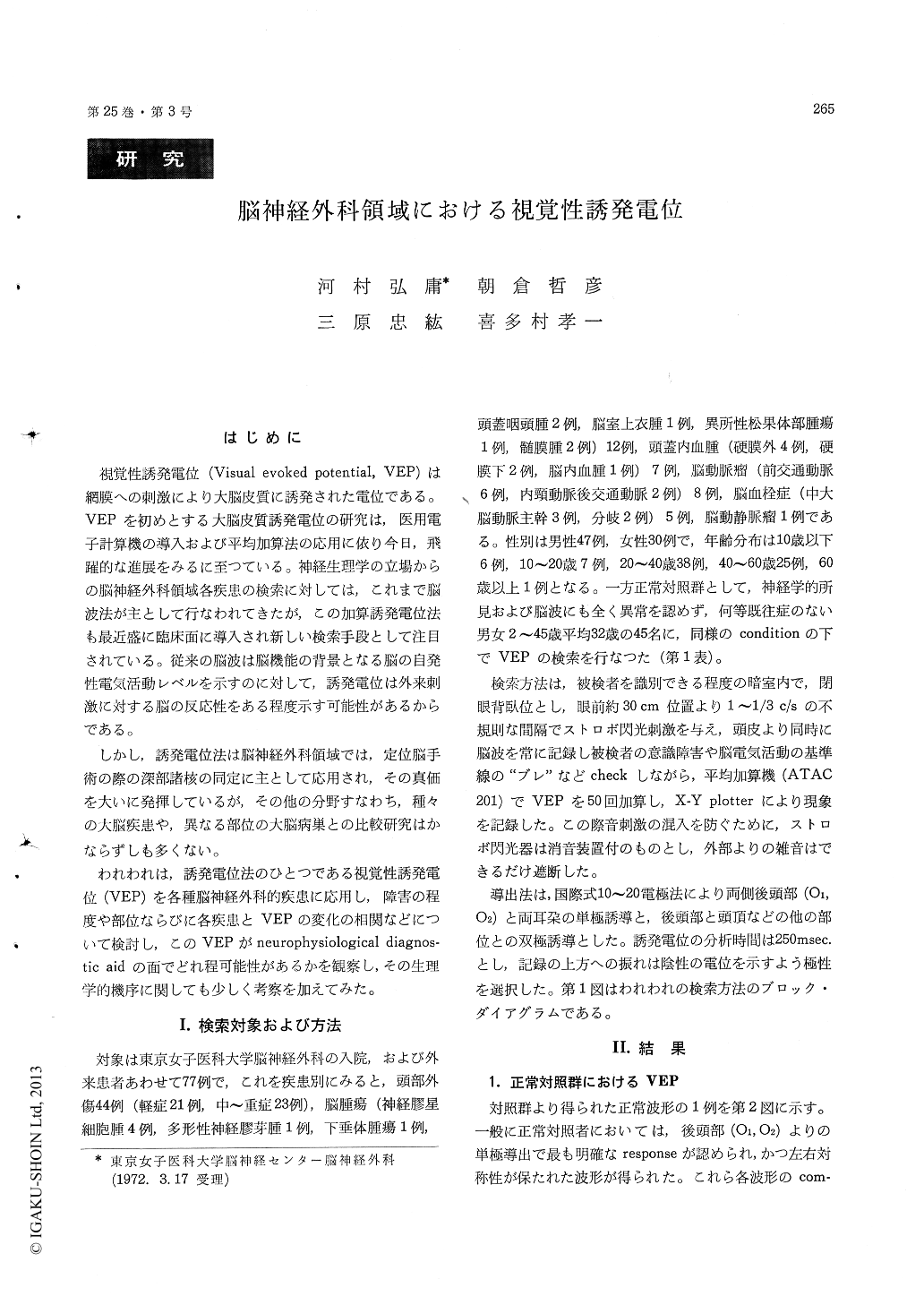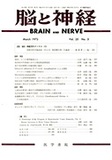Japanese
English
- 有料閲覧
- Abstract 文献概要
- 1ページ目 Look Inside
はじめに
視覚性誘発電位(Visual evoked potentiaL, VEP)は網膜への刺激により大脳皮質に誘発された電位である。VEPを初めとする大脳皮質誘発電位の研究は,医用電子計算機の導入および平均加算法の応用に依り今日,飛躍的な進展をみるに至つている。神経生理学の立場からの脳神経外科領域各疾患の検索に対しては,これまで脳波法が主として行なわれてきたが,この加算誘発電位法も最近盛に臨床面に導入され新しい検索手段として注目されている。従来の脳波は脳機能の背景となる脳の自発性電気活動レベルを示すのに対して,誘発電位は外来刺激に対する脳の反応性をある程度示す可能性があるからである。
しかし,誘発電位法は脳神経外科領域では,定位脳手術の際の深部諸核の同定に主として応用され,その真価を大いに発揮しているが,その他の分野すなわち,種々の大脳疾患や,異なる部位の大脳病巣との比較研究はかならずしも多くない。
Visual evoked potentials (VEPs) recorded trans-cranially were studied in 56 patients with organic brain lesion, 21 cases of post-traumatic sequelae in narrow sense and in 45 normal healthy subjects.
The subjects lying with closed eyes on a bed in the EEG laboratory, were sustained with a sequence of flashes from a stroboscope placed in front of themselves and flickered by a photic stimulator.
Electrodes were placed at the occipital and parietal regions according to the 10-20 electrode system, with reference electrodes on both ear lobes. Electro-encephalographic responses to fifty flashes of 1 or 1/3 cycle per second were additively summed up by means of a digital type of computer. The results were visualized on a screen and recorded by an X-Y plotter. During the stimulation, usual EEG also recorded in order to check the consciousness level of the subjects.
The analysis time of VEP was 250 msec. and the upward deflection indicates negative electricity.
1) In healthy subjects, VEPs appeared symmet-rical pattern between the two hemispheres pro-minently over the occipital region. Although there were some inter-individual variations, five peaks could be identified in the normal VEP.
2) Abnormal VEPs were found in 16 out of 21 patients who had colorful complaints without any abnormal neurological and/or electroencephalo-graphic finding (so called in post-traumatic sequelae). Abnormality of VEP in these patients could be classified in 4 types.
3) Abnormal VEPs were found in 15 cases out of 33 (45. 4%) localized organic brain lesions. Com-paring with the incidence of abnormal VEPs in superficial lesions and that in deep lesions includ-ing brain stem disorder, the higher incidence of abnormal VEP was significantly observed in deep lesions (63. 0%) than in superficial lesions (35. 7%). The most frequently observed changes in VEPs were lowering of the amplitude and delayed latency of the lesion side. However, the changes seemed to be non-specific for each pathological change. No correlation between VEP changes and the clinical manifestations were found in many cases.
4) So far as the focal diagnosis of a brain demage was concerned, the value of VEP seemed to be not necessarilly more beneficial than conventional EEG. However, from physio-pathological point of view, VEP recording was considered to be so useful to detect even a traumatic minimal brain damage and prognosis of brain stem lesions including di-encephalic and mesencephalic disorders.
The authors discussed the possibility of the clinical application of VEPs and reviewed briefly on comparable lectures.

Copyright © 1973, Igaku-Shoin Ltd. All rights reserved.


